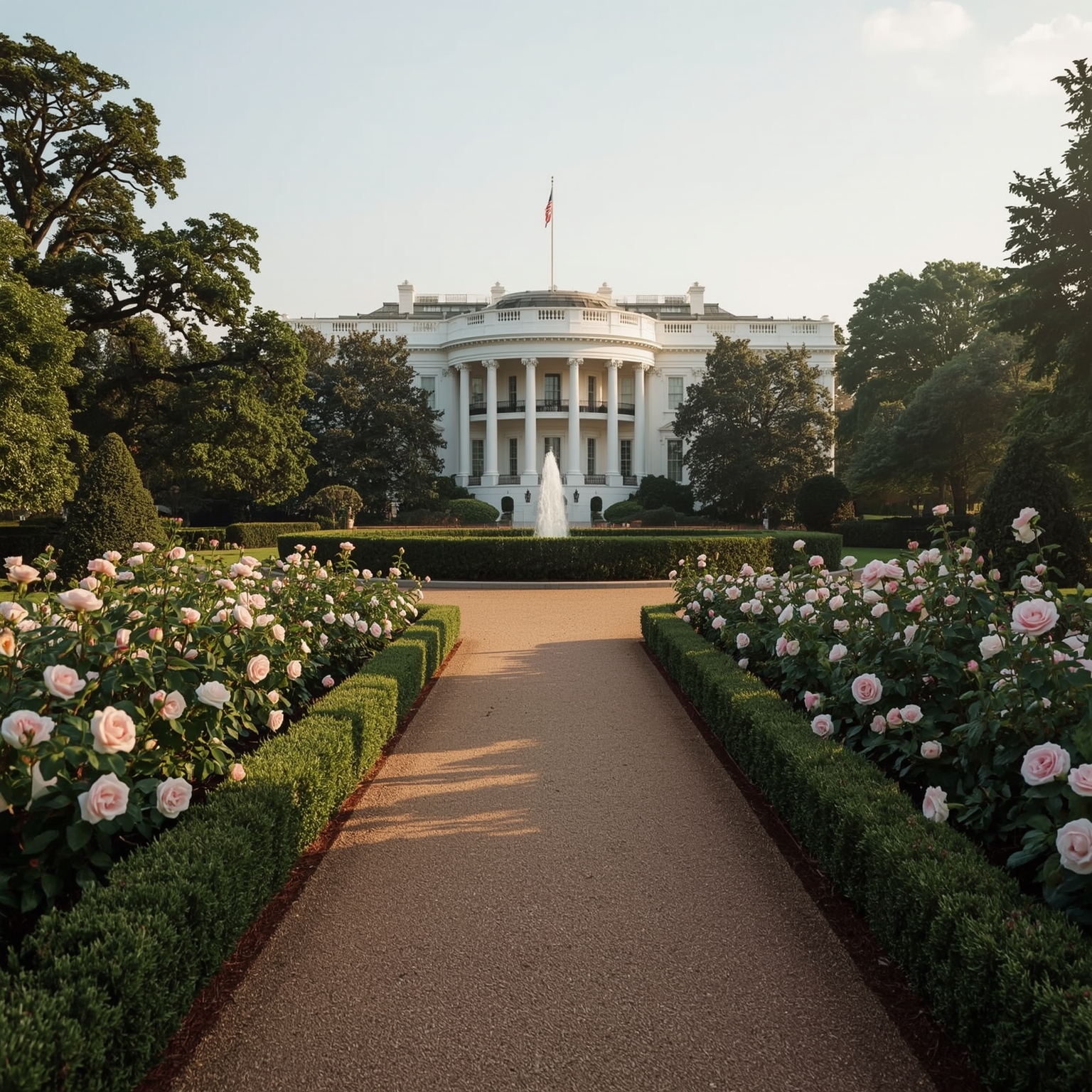Updated\n2025-09-04T19:30:54Z\nShare\nFacebook\nEmail\nX\nLinkedIn\nReddit\nBluesky\nWhatsApp\nCopy link\nlighning bolt icon\nAn icon in the shape of a lightning bolt.\nImpact Link\nSave\nSaved\nRead in app\nThis story is available exclusively to Business Insider\nsubscribers.\nBecome an Insider\nand start reading now.\nHave an account?\nLog in\n.\n\nThe White House Rose Garden, one of the nation’s most symbolic and recognizable outdoor spaces, embodies more than a century of evolving design, presidential influence, and cultural significance. Its origins trace back to 1913, when Ellen Wilson, spouse of President Woodrow Wilson, created the first official iteration of the Rose Garden. Yet even before Ellen’s vision was realized, the land that now frames the West Wing was hardly serene: it once held horse stables and, later in 1902, First Lady Edith Roosevelt laid the groundwork for refinement by establishing the Colonial Garden. This early garden reflected her personal touch, featuring daisies, wildflowers, Johnny jump-ups, and boxwood that she herself arranged with care. Although charming, Edith’s Colonial Garden would eventually give way to Ellen Wilson’s conception of the Rose Garden, forever transforming the space into a celebrated landmark.\n\nEllen Wilson’s 1913 plan departed from whimsical informal planting beds and instead introduced structure and grandeur: rows of blossoms with a wide central lawn framed by carefully chosen flowers. Architects and designers George E. Burnap and Beatrix Farrand contributed to its earliest design elements, favoring order over winding, cottage-style paths. Initially more ornamental than ceremonial, this early Rose Garden functioned primarily as a meticulously maintained flower garden, not yet as the grand stage for press conferences or national announcements that it would later become.\n\nBy the early 1960s, a major reimagining occurred under the Kennedy administration. After touring elaborate European formal gardens, President John F. Kennedy concluded that the White House lacked a comparable outdoor environment worthy of hosting dignitaries and state ceremonies. His vision was actualized by Rachel Lambert Mellon in 1961, whose horticultural sophistication reshaped the Rose Garden into an elegant blend of practicality and beauty. Mellon’s design incorporated perennial beds, abundant roses, annual flowerings, and the stately Katherine crab apple trees, while also framing the lawn with green pillows of foliage. Inspired in part by the serene landscaping of the Frick Museum in New York, she introduced four magnolia trees at the garden’s corners, lending symmetry and grandeur. By 1963, when photographs captured John F. Kennedy among the tulips and blossoms, the Rose Garden had become a symbolic expression of American prestige on par with its European counterparts.\n\nOver the decades, the Rose Garden grew into not just a landscape, but a stage for American history. In 1971, it witnessed the unprecedented outdoor wedding of Tricia Nixon, daughter of President Richard Nixon, to Edward Finch Cox. Although she was the eighth presidential daughter to marry at the White House, Tricia was the first to marry outdoors in a ceremony attended by four hundred guests, after which the celebration continued indoors in the East Room. The Rose Garden had thus proven capable of hosting intimate yet momentous national memories. In the 1980s, the garden even played host to lighter presidential moments, such as when Ronald Reagan famously amused himself by feeding squirrels burrowed among the plantings. Its proximity to the Oval Office made it especially appealing as a quick retreat into nature for presidents needing respite from the pressures of governing.\n\nBeyond leisure, the Rose Garden became an important platform for national announcements and ceremonies. In 1993, President Bill Clinton introduced Ruth Bader Ginsburg to the nation from its carefully manicured grounds when nominating her to the Supreme Court, underscoring the symbolic weight of the garden as a setting for history-making pronouncements. The tradition continued into the twenty-first century: in 2009, President Barack Obama and Vice President Joe Biden convened in the Rose Garden with Professor Henry Louis Gates Jr. and Sergeant James Crowley in the spirit of reconciliation following their widely publicized controversy. Occasionally, a small seating area permitted informal lunches and private discussions, lending an additional dimension of intimacy.\n\nFirst Lady Melania Trump ushered in significant modifications in 2020. Seeking to better equip the garden for press events and ceremonies, she added modern technical accommodations, improved infrastructure, and replaced some pathways with pale limestone walkways to border the central lawn. Many historic features were preserved, such as the magnolias first introduced by Mellon, while roses blooming in white and pastel shades softened the new layout. Yet certain treasured elements shifted: more than a dozen crab apple trees tracing back to the Kennedy redesign were transplanted elsewhere, and an established seating nook disappeared in favor of an art installation.\n\nMost recently, during Donald Trump’s second, non-consecutive term, the Rose Garden underwent yet another dramatic transformation. In August, the White House unveiled a new design where sections of manicured grass were paved over to form a large stone patio, accented by tables sheltered with yellow and white striped umbrellas reminiscent of his Mar-a-Lago club terrace. Trump himself had remarked that the original lawn “just doesn’t work” for sizeable gatherings, emphasizing functionality over tradition. In keeping with his preference for bold, emblematic touches, the new paving featured tiles emblazoned with symbolic motifs — prominently the presidential seal in glimmering gold, as well as stars and stripes echoing the American flag. When asked to describe the space, White House spokesperson Davis Ingle playfully dubbed it “The Rose Garden Club,” characterizing it as the most desirable venue in Washington, if not globally.\n\nFrom a pastoral horse stable to a Colonial-inspired garden, from Ellen Wilson’s original plantings to Kennedy’s European-inspired reimagining, and finally to conspicuous redesigns in the twenty-first century, the Rose Garden has evolved through layers of symbolism and transformation. Each administration, influenced by personal aesthetics and political priorities, has left its mark, ensuring that the Rose Garden exists not merely as a patch of ornamental flora, but as a living stage on which American history, presidential identity, and public memory continue to converge.
Sourse: https://www.businessinsider.com/melania-trump-white-house-rose-garden-design-history-2020-8



